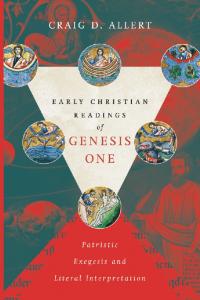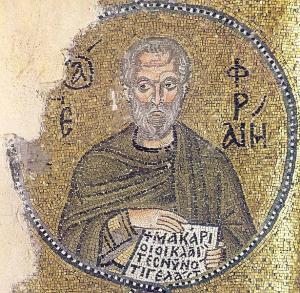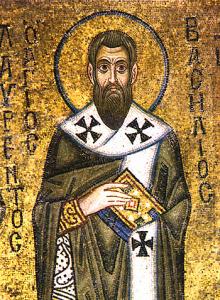 In Chapter 6 of Early Christian Readings of Genesis One Craig Allert turns to readings of the days of Genesis in the early Church Fathers. He looks at three writers, Theophilus of Antioch (ca. 120-185 exact dates uncertain), Ephrem the Syrian (ca. 306-373), and Basil of Caesarea (ca. 329-379) – spending the longest with Basil. Although these three appear to take the days of creation literally – with Basil commenting on the length of a day as 24 hours – the focus isn’t on material creation in any concrete sense. Rather patterns and types, apologetics against prevailing errors of doctrine, and/or the theological significance of creation are at the forefront.
In Chapter 6 of Early Christian Readings of Genesis One Craig Allert turns to readings of the days of Genesis in the early Church Fathers. He looks at three writers, Theophilus of Antioch (ca. 120-185 exact dates uncertain), Ephrem the Syrian (ca. 306-373), and Basil of Caesarea (ca. 329-379) – spending the longest with Basil. Although these three appear to take the days of creation literally – with Basil commenting on the length of a day as 24 hours – the focus isn’t on material creation in any concrete sense. Rather patterns and types, apologetics against prevailing errors of doctrine, and/or the theological significance of creation are at the forefront.
Theophilus is the earliest of the three. His focus is clearly on the patterns and types he discerns in the text, although he also notes that the order counters the philosophers who will put God aside. The plants come before the sun and stars and thus cannot be produced by these luminaries. God himself is the source of plants. Allert gives a sampling of the types and patterns that dominate Theophilus’s comments on the days of creation: The sun is a type of God, always full not waxing and waning. The moon is a type of man and “waxes as a pattern of the future resurrection.” (p. 231) The stars created on the fourth day also carry lessons: “The disposition of the stars has correspondence to the arrangement and rank of those who keep the law and commandments of God. The brightest stars, which remain in place and are unswerving, exist in imitation of the prophets. The stars of secondary brightness are types of righteous people. But the planets, the stars “which pass over and flee from one position to another,” are a type of the men who wander from God.” (p. 231)
Theophilus doesn’t read the creation account as some kind of science or history lesson, but as a source of wisdom and insight into God and into the the moral nature of humankind.
 Ephrem the Syrian reads the days of creation as 24 hour days, but he also “connects the days of creation with the incarnation of Christ.” (p. 233) Allert suggests that, although Ephrem reads the days in a literal manner, there are other more important issues at focus. “While there is a definite temporal chronology that Ephrem assumes, his emphasis is on the reason for the order. That is, he shows a greater interest in prioritizing the story’s coherence than with proving the actual literal history (in our understanding). This is characteristically Antiochene and substantially curbs our desire to make more out of the temporality than Ephrem himself does.” (p. 240)
Ephrem the Syrian reads the days of creation as 24 hour days, but he also “connects the days of creation with the incarnation of Christ.” (p. 233) Allert suggests that, although Ephrem reads the days in a literal manner, there are other more important issues at focus. “While there is a definite temporal chronology that Ephrem assumes, his emphasis is on the reason for the order. That is, he shows a greater interest in prioritizing the story’s coherence than with proving the actual literal history (in our understanding). This is characteristically Antiochene and substantially curbs our desire to make more out of the temporality than Ephrem himself does.” (p. 240)
The most interesting discussion, however, comes in the consideration of Basil’s writings on creation. In Genesis 1:5 we read God called the light day, and the darkness He called night. And there was evening and there was morning, one day. (NASB) Most English translations call this the first day – but the NASB is an exception and apparently the more literal translation. Basil, in fact, wondered why the writer of Genesis used one instead of first. Certainly “first” would make more sense, as most English translators agree. The first day comes before the second, third, fourth, fifth and sixth days. The use of “one” instead of first could signify the establishment and naming of the unit of time “day.” This would be an important act of creation, as time began only with creation.
 More significant is the connection of the one day with the eighth day making full cycle of a week. In On the Holy Spirit Basil writes “We pray standing, on the first day of the week, but we do not all know the reason. On the day of the resurrection [or “standing again,” Greek ἀνάστασις] we remind ourselves of the grace given to us by standing at prayer, not only because we rose with Christ, and are bound to “seek those things which are above,” but because the day seems to us to be in some sense an image of the age which we expect, wherefore, though it is the beginning of days, it is not called by Moses first, but one. For he says “There was evening, and there was morning, one day,” as though the same day often recurred. Now “one” and “eighth” are the same, … the state which follows after this present time, the day which knows no waning or eventide, and no successor, that age which endeth not or groweth old.” (Allert p. 259-260 quoting Basil NPNF 2-8 p. 42)
More significant is the connection of the one day with the eighth day making full cycle of a week. In On the Holy Spirit Basil writes “We pray standing, on the first day of the week, but we do not all know the reason. On the day of the resurrection [or “standing again,” Greek ἀνάστασις] we remind ourselves of the grace given to us by standing at prayer, not only because we rose with Christ, and are bound to “seek those things which are above,” but because the day seems to us to be in some sense an image of the age which we expect, wherefore, though it is the beginning of days, it is not called by Moses first, but one. For he says “There was evening, and there was morning, one day,” as though the same day often recurred. Now “one” and “eighth” are the same, … the state which follows after this present time, the day which knows no waning or eventide, and no successor, that age which endeth not or groweth old.” (Allert p. 259-260 quoting Basil NPNF 2-8 p. 42)
Basil focuses on a theology of the Lord’s Day connecting the first day of creation with the first day of the week on which the Lord was raised and new creation begins. In the Hexameron on the days of creation, the Lord’s Day is “connected with the eighth day which is “outside this week of time.” This day is “without evening, without succession, and without end.” (p. 264)
The first day of the week, in Basil’s thinking, serves as the visible symbol that leads toward eternity. The day on which light was created and the day on which Jesus rose from the dead is commemorated every week in the Sunday worship of the church. There is unity in each of these days or ages, and this then signifies the oneness of the age to come. …
Basil is making a fundamental contrast between the seven days, which is a figure of the present world, and the eighth day, which is a figure of the world to come. The Lord’s Day is both “one” and “the eighth.” It is “one” in that the future life is “one” without any succession of time. It is “eighth” in that “seven days” is a figure of the world to come. (p. 264)
The early church fathers read the days of Genesis one in deep and varied ways. They saw a Christological significance that goes far beyond any “literal historical” reading in the modern sense.
If you wish to contact me directly you may do so at rjs4mail[at]att.net
If interested you can subscribe to a full text feed of my posts at Musings on Science and Theology.















